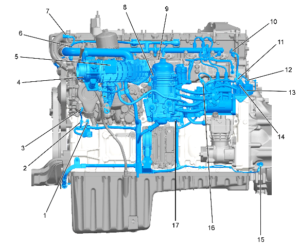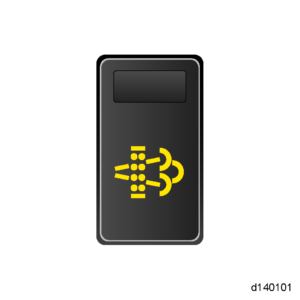Hydrocarbon Doser Fuel Line Pressure Low SPN 3480/FMI 2
Description Hydrocarbon (HC) Doser Fuel Line Pressure Low
Monitored Parameter HC Doser Fuel Line Pressure
Typical Enabling Conditions Dosing Enabled
Execution Frequency Continuous When Enabling Conditions Met
Typical Duration One Minute
Dash Lamps MIL, CEL
Engine Reaction Derate 10%
Verification Parked Regeneration
TROUBLESHOOTING:
- Are there any fuel system faults present?
- Yes; repair fault with the highest priority listed below. Verify repair. 3480/3, or 4 4077/3, or 4 3480/1, 4077/14
- No; Go to step 4.
- Start the engine.
- Using DiagnosticLink, perform two back-to-back “Purge Hydrocarbon Doser” service routines to help improve the chances of identifying a leak.
- Turn the ignition OFF.
- Visually inspect the fuel line between the HC doser block assembly and fuel doser injector valve for any sign of external fuel leaks. Are any external leaks present?
- 1. Yes; replace the HC doser injector valve fuel supply line. Go to step 8.
- No; replace the HC fuel doser injector valve. Refer to section “Removal of the Hydrocarbon Doser Fuel Injector Valve” . Go to step 8.
- Turn the ignition ON and start the engine.
- Clear fault codes.
- Perform a parked regeneration to verify the repair. Did SPN 3480/FMI 2 become active during regeneration?
- Yes; replace doser block. Refer to section “Removal of the Hydrocarbon Doser Fuel Injector Valve” . Verify repair.
- No; release vehicle.


 GHG14 1 BOX
GHG14 1 BOX
 EPA07/10/GHG14 Exhaust – EGR – ATS Manual (DDC-SVC-MAN-0083) | 37 EPA10/GHG14 Aftertreatment System Overview | 37.9 Performing a Parked Regeneration – EPA10/GHG14When the parked regeneration request is accepted, the Diesel Particulate Filter (DPF) Regeneration lamp will turn ON one time for one second and then turn off for the remainder of the parked regeneration. The High Exhaust System Temperature (HEST) lamp will flash for one second every ten seconds and eventually become solid when the tailpipe temperature is above 525°C (977°F).The engine speed will increase to 1100 RPM for all DD Platform engines. The regeneration will take 30 to 40 minutes. The regeneration is complete when the engine returns to low idle and the DPF lamp remains OFF. The HEST lamp will remain ON, but the vehicle may be driven.
EPA07/10/GHG14 Exhaust – EGR – ATS Manual (DDC-SVC-MAN-0083) | 37 EPA10/GHG14 Aftertreatment System Overview | 37.9 Performing a Parked Regeneration – EPA10/GHG14When the parked regeneration request is accepted, the Diesel Particulate Filter (DPF) Regeneration lamp will turn ON one time for one second and then turn off for the remainder of the parked regeneration. The High Exhaust System Temperature (HEST) lamp will flash for one second every ten seconds and eventually become solid when the tailpipe temperature is above 525°C (977°F).The engine speed will increase to 1100 RPM for all DD Platform engines. The regeneration will take 30 to 40 minutes. The regeneration is complete when the engine returns to low idle and the DPF lamp remains OFF. The HEST lamp will remain ON, but the vehicle may be driven.